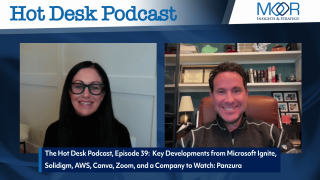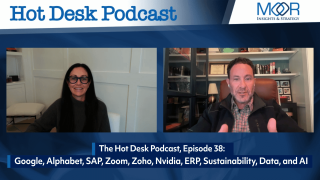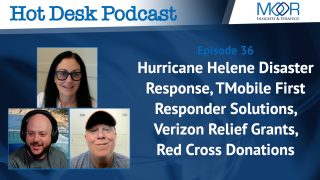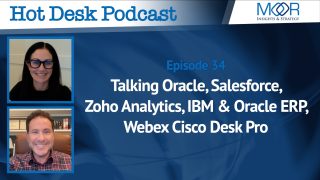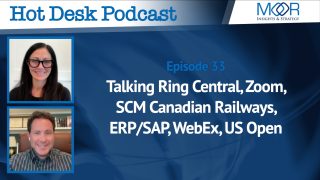It’s Episode 37 of the MI&S Hot Desk Podcast! Join Robert Kramer and Melody Brue for a rundown of what’s been happening on the road over the past few weeks with Cadence Fem.AI Summit, Microsoft, Miro, Zoomtopia, AdobeMAX, IBM, Infor, LogicMonitor, Teradata and AWS.
Watch the full episode here:
Listen to the audio here:
00:00 Intro
5:28 Cadence Fem.AI Summit
7:59 Microsoft Industry AI Summit
11:55 Miro Innovation Workspace
13:46 Zoomtopia
19:09 AdobeMAX Content Credentials Web App
22:48 Infor
25:31 Logicmonitor
26:35 Teradata
28:25 AWS
Cadence Fem.AI Summit
- Cadence Launches Fem.ai to Close the AI Gender Gap
- Melody’s LinkedIn post about the Cadence Design Systems Fem.AI Summit
- Melody’s LinkedIn post about International Women In AI Day and Fem.AI
Microsoft Industry AI Summit
Miro Innovation Workspace
Zoomtopia
AdobeMAX Content Credentials Web App
- Adobe Debuts Free Web App to Fight Misinformation and Protect Creators
- Melody’s post on LinkedIn from AdobeMAX
Infor
Logicmonitor
Teradata
AWS
Disclaimer: This show is for information and entertainment purposes only. While we will discuss publicly traded companies on this show. The contents of this show should not be taken as investment advice.
TRANSCRIPT
Robert Kramer: Hello everyone. Welcome to this week’s edition of Moor Insights & Strategy Hot Desk Podcast. We’re on Episode 37. I’m Robert Kramer and joined by Melody Brue, and we’re both vice presidents and principal analysts, and I handle ERP and Enterprise Data. Mel handles Modern Workplace and HCM CX and a bunch of other things. On this show, we like to talk a little bit about tools, trends, trajectories, and people and marketing technologies, enterprise apps, a lot of other things like ERP, CRM, and the glue that holds it all together is data. So this week, Mel, I’m going to introduce the topics in just a second, but we’re at night. It’s late in New York. I’m on the road. You’re just getting home from the road. We wanted to catch up. We haven’t talked a little bit in a while and we’re going to jump into where we’ve been and we’re going to air tomorrow. But I’m going to talk a little bit about Teradata and LogicMonitor, AWS Infor, and you’re going to go over Adobe, Zoom. What do we have? Cadence and Microsoft…
Melody Brue: Microsoft, Miro, Zoom. Yeah, I mean this is crazy, but when people are watching this, it’s going to be the morning or the afternoon or whatever, but it’s 10:45 at night for us. I just got in from Miami. We’re catching up now, but there’s been so much going on and we’ve both been on the road for weeks in a row and there’s so much content that I feel like we’re publishing, but sometimes talking about it is we just have to share the things and I feel like there’s so much that we kind of have to do this rapid fire.
Robert Kramer: Just real quick, do you sometimes see that there’s some synergy between some of the vendors, like the way that they talk about technologies or the way that they’re presenting it to us, or do you think they’re all mutually exclusive or a little both?
Melody Brue: No, I think there’s a ton of synergy and actually it’s been so interesting to see over the last couple of weeks for me going to events, some in person and some virtually, and I mean I’ll touch on this as I get to them, but even just, I just landed a couple of hours ago from AdobeMAX in Miami and last week I was in San Jose. I’m like, where was I? San Jose for Zoomtopia? But I also was kind of watching what Miro was doing with their announcements. But Miro made an announcement with Adobe integrating Adobe Express into their new platform, and then I saw it in person at Adobe. I was also with Zoom, they integrated with some other partners that I work with. So I’m with people and then I see it happening at another event. I actually had a conversation just today that was really interesting that there’s so much collaboration happening throughout enterprise software that it is actually really satisfying to me and it’s actually not just software, it’s hardware too.
And you see it with chip makers, with PCs, with everything. And a couple of years ago I wrote something in Forbes and I said, collaboration is the new competition and a bunch of trolls on Twitter called me naive and I now want to find these people and say, look, do what Pat calls a victory lap. But it really is. And you look at something like that and you see Miro, this is a collaboration kind of whiteboard platform and it makes a whole lot of sense for Adobe to integrate into Miro because if you are collaborating in that space and you don’t have to leave to edit an image or do something that actually keeps you in your zone, and this is a lot of developers work in this platform, marketers work in this platform, so you don’t have to leave. They’re also integrating with Box and with others. I mean there’s a ton of others. So you start to see all of these things that maybe you wouldn’t have thought of, but then you see it and you’re like, oh, that makes a lot of sense to me. So to answer your question, yes, I’m seeing that a lot.
Robert Kramer: Well, like you said, you build, you buy, or you partner, and then it makes it a lot more efficient and you’re bringing the features today versus later, and it’s all about the customer at the same time and it’s so competitive. Where do you want to choose your battles or how do you continue to innovate at the level that’s required to be competitive or to give the customers what they need? I mean, there’s a lot of discussions of that at the enterprise ERP level, which we can talk about as well, but I think it’s been a change like you’re saying for the better.
Melody Brue: Yeah, so let’s go through super rapid fire where I’ve been, and I’ll go back to the beginning of the month. I was at the Cadence Fem.AI Summit that happened in Palo Alto. So Cadence Design Systems, they put $20 million into this initiative to really support more women in AI. It was an incredible event. I’m actually going to be doing a Six Five video to explain more about the event. It was really incredible. That should air, actually I think October is National Women in AI month, so we can celebrate this all month long, but a ton of really awesome speakers there, a bunch of different initiatives really that are aiming to close the AI gender gap, and it’s really not entirely focused on AI, but STEM. Cadence does a lot of things around this that really support women in technology. But AI initiatives are so important right now because if we don’t catch women and girls now when we know even from research that a bunch of different people, but Cisco has recently done research that have said the people that will be most affected by AI in terms of job loss will be the frontline workers.
And I’m at a loss for words right now because I’m so tired… entry level workers. So if we don’t train people at that entry level, which Cisco is doing with some of their academies, Cadence is doing, I actually found out this week at AdobeMAX that Adobe is training like 3 million people to learn generative AI through their different processes, their tools, because if we don’t start teaching, and it’s not just women, but Cadence is really in this particular Fem.AI initiative, really concentrating on women, we’ve got to get to people now there’s this big upskilling initiative throughout a lot of different organizations and Cadence also announced that companies like Nvidia, Workday, NetApp and others have joined them in this initiative. So I said, I’m going to go through rapid fire on this and I’m going to rapid fire from there, I went to Boston to Microsoft, their Industry AI summit.
This was really interesting because we got to look at AI for specific industries. So my tracks that I went to, I concentrated really on finance, healthcare, and retail. So these solutions that are really built specifically for these verticals, I made a joke of this thing that I thought that Copilot for Finance should be called Bro Pilot. That was my big finance bros get it, but some really, really interesting things happening there. And with Copilot for Finance, that’s a tricky thing because there’s so much regulation around that. So they have to really train Copilot to be incredibly smart around the specific data for the company and in that Microsoft graph where it is very much contained within that data. Then in healthcare we got this amazing demo. It was actually quite impressive where they actually brought in an actual physician and did sort of a patient physician demo where the physician didn’t actually take any notes.
The Copilot was taking the notes for the physician and we saw something similar at Oracle and that really frees up the physician to pay more attention to the patient, to actually think through what’s happening. Also allows the AI to then deconstruct everything that the patient is saying and maybe pull things out that the physician may not have thought through, make sure that everything is compliant. So there’s a lot to that, but this physician that they had there had actually been using it in her clinic. So this was not somebody who was just there to do a demo. She’s actually been using it. So it was a really cool demo to see. I think there’s still a lot that we need to see in that space I think for people to trust it. The demos were great. I think as we move from the Copilot to the agents, Microsoft talks about agents in a slightly different way than some of the other companies, some of the other vendors that we talked to about agents.
So I think the agents being completely autonomous and making decisions on your behalf versus agents that are carrying out automation. Microsoft is still working on that, on their language around that. But the demos I think showed a lot of promise in what they can do and a lot of investment in catering to specific industries and not just saying, this is a catchall AI and it will do what you want it to do. It was very tailored to this is a retail solution, this is a healthcare solution, this is a finance solution and very much tailored to that. And so that was really good to see and looking forward to watching the progress on that onto the next thing, which I was not able to go to live, but Miro introduced their innovation workspace, which is an AI enhanced platform for this innovation process. It’s kind of like a whiteboarding tool for fast prototyping that has smart templates. It’s like this centralized hub for projects workflows.
It is probably – not probably – it is Miro’s biggest update I think in the company’s history on development for new products, launching new products and services. I think that this is kind of pushing Miro over the edge in terms of being competitive with their competitors like Mural and Lucid Spark. Some others. They’re really, I think this was a big turning point for them. And I actually have written up an analysis of this and I feel very fortunate that we now have a DevOps person on our team, Jason Andersen, who actually is helping me with some hands-on and experience, Miro gave us a some access to the platform and so Jason is contributing his hands-on experience with the platform. So we will be publishing our thoughts on that in the next, well, I don’t know if it’ll be by the end of the week or not, but we’ll try maybe early next week after that. I was at Zoomtopia. There was a lot going on there,
Robert Kramer: Swag yet.
Melody Brue: Oh, did you see the swag video?
Robert Kramer: No.
Melody Brue: Oh, that’s so funny that you say that. So I’ll actually link that. So Zoom did a really cool thing… So Zoomtopia sometimes it’s their big user conference and everything. Sometimes Zoomtopia has been quite large; this year they actually made it a little bit smaller. It was a more kind of intimate gathering. They opened this experience center, which was really cool. So it was a little bit smaller, more intimate, but that meant that there wasn’t this big kind of showroom floor experience that you typically have where they would have partners with booths and all the things. And typically those partners would be Logitech, Avaya, the ones you would expect. So rather than having those booths, they had a kind of swag bag with stuff from those vendors.
Robert Kramer: Oh, nice.
Melody Brue: And so my fellow analyst and good friend Craig Durr from The Collab Collective and I did an unboxing of all the swag, so I will link it in the show notes because we had a good time doing it. But Zoom where their big announcements, I mean I think their biggest announcement was around their AI Companion. They made a big upgrade to their AI Companion 2.0. That’s just kind of what you would expect. It summarizes meetings, it generates your tasks, emails, books your meetings, all of that kind stuff. But I think the biggest update on AI Companion is that you’ll be able to personalize it in that’s coming I think early 2025. And again, industry specific. So they will be having AI powered features that are specific for industries like healthcare and education. Zoom does. They are very, very strong in AI and I don’t know that everybody knows that and I think people know that if you’ve ever used their AI summaries, you probably know that they’re quite good.
If you’ve ever been on a Zoom call and somebody says, oh sorry, my dog’s barking, and you’re like, I don’t hear your dog. Their noise cancellation is superior, things like that. But I gave the analogy to the Zoom team that this is sort of a long analogy, so I’m going to make it really quick. I think where we have to kind of tell the Zoom story is their AI is actually, it’s not all about, you can’t just tell the story of the outputs or the outcomes. You have to tell the story of how you get there. And my analogy was like, take two cars. You’re both going to end up there at some point, but my car might be safer and it doesn’t leak oil or gas. And that’s kind of how I look at things like that. And I use this analogy today with Adobe as well. You have to tell that story because eventually all of the tools and all of these AI outcomes are eventually going to be the same. And so the things like how the model is trained, the security of the model, the data that goes into it, that stuff is the important stuff. It’s how the car is built and the security, the safety of the car, what it leaks, what’s put into it, how you get there is actually more important than the fact that you arrived.
So that’s the story that we need to be telling. So they have, Zoom has so much beyond meetings and they are really making a bigger attempt at telling that story. And Zoomtopia was a really big attempt at doing that. And again, talking about partnerships and connections. So with Zoom AI Companion, you can connect your own data with third party apps like Jira and Salesforce, so your AI assistant can pull all that information to help you complete those tasks across different platforms. Again, have to get that story out because otherwise people think like, oh yeah, I just hop on a Zoom meeting. People don’t realize all the other things you can do on Zoom.
But again, that is, I was just there last week and I will be writing up a big much more extensive writeup on all the things there. We’re running out of time already and I still have one more, so I’m going to get to it really quick because I will have both a video and a full recap of AdobeMAX. So I will tell you my big highlight of AdobeMAX is… AdobeMAX is really about the creative community, and I actually published today in Forbes and that will link in the show notes. Last week, Adobe announced a free web app that they launched to is part of their content credentials that really is to design to address this growing threats of misinformation and concerns around unauthorized content used. So it addresses two things. One, it allows creators to embed this content credentials into their work, allows them to say, do not use my work to train your models.
It also allows users or viewers to look at things and understand is this made with ai? Can I trust this image or is AP or New York Times or whatever it is that you’re viewing, however you consume information, you can basically read this as a nutrition label and decide, do I trust this? I look at this as sort of a primer for everything that was announced at AdobeMAX as the fact that they’re enabling these content authenticity credentials into everything that they do and allowing it as a free app to anybody. It is not like you don’t have to be a user of Adobe products.
It’s so important as we get deeper and deeper into AI tools. I will go way deeper into AdobeMAX. It was super great. There’s so many things around Adobe Express that I love that I think just allowing people who aren’t traditional creators or creatives to be a part of the creative community and a part of getting content out there, that content velocity. That’s part of what the video that I did to that will be a Six Five video that was the gen studio for performance marketing. So so many announcements, but I think that was the crux of it that I think is super important, which is how are we going to use AI moving forward and how do we protect both creatives and consumers of AI content to know what you’re looking at and feel that that’s safe for you?
Robert Kramer: Wonderful.
Melody Brue: I think that was longer than I wanted it to be, so you’re going to have to even go faster. So where have you been?
Robert Kramer: I’m in New York right now for IBM’s Analyst Forum, and not to give too much away, but we’re talking to the leaders and learning their strategies and their visions around AI. I’m putting my opinions in where some of the core of this data comes from, which is ERP and how ERP influences a lot of the trends that I’m going to talk about in a few seconds on a lot of these innovations. So I was in Las Vegas I think about two and a half weeks ago for Infor, and Info is one of the leaders in ERP, and actually I stayed at the new Fontainebleau in Las Vegas, which I highly recommend. It was really nice and quiet, but they’re gearing towards, like you mentioned, industries with Microsoft. They’re gearing towards industry specific for their cloud platform. Now, Infor’s story is that they started as they’re owned by the Koch Industries Investment Group, which actually I think owns or has a stake in the Fontainebleau, by the way.
So anyway, they put together just an enormous amount of ERP companies into this Infor product, but they’re gearing to try and get companies from legacy into the cloud, which is really a major talkative item because most enterprises are still on-prem. I don’t have the exact numbers, but I’d say maybe two thirds of enterprise ERPs might be on-prem or hybrid, so like that, and then a third are in the cloud. But all this is great technology. We’re talking about needs to have some capabilities to access the data in the cloud. And so the core functionalities that they’re adding for this cloud platform are AI assistance and process mining. But I really like that they are going towards the sustainability modules and tenant to support production and inventory and operations and compliance and environmental goals. But I still think there’s a major issue with how do we get these legacy companies or legacy softwares from these enterprises off-prem into the cloud.
And one of the things, I’ll move on to the next one after this, Infor has created processes for each industry to utilize. So back in the day when we were doing a lot of on-premise, they had what we call switches and then we did customizations. And so they were unique for each company, but if you have it by industry, you learn something from the other companies that are in that industry, and it might be a better way to do it than you’re doing because once you start bastardizing the system, then you have inabilities to migrate to the newer version. So they’re actually really focused on it. And I will go back to what I talked about a long time ago is data management and change management are major components here and trusting your vendors to actually to get to that next step, which is the cloud. Then I went to LogicMonitor, which is in Austin, which was a great place and home of where you live in our company,
Melody Brue: My hometown, although I wasn’t here,
Robert Kramer: They’re not directly associated with the ERP, but they are observability platform. They had some great customers there at McKesson and Topgolf and AppDirect, and they’re putting AI embedded throughout their whole product and it’s allowing the agents also AI agents to actually work to actually help with some of the operation and picking up anomalies and things like that. But one of the things that they are going to try and get to because they have had a lot of growth, is how do they get to the next level? Not substantial compared to some of their competition, but they have the capabilities because they have some really good customers. So my advice to them was to focus on how you can actually take some of this ERP data and actually do some things with some of the observability with it, and it could actually tackle some of the sustainability that is going to be required.
That’s another subject. Let’s go keep on going. And I was at Teradata, which is they were actually in LA, a data intelligence platform, and they released some really neat things. They’re transitioning to a hybrid model with AI embedded, and they have some great new partnerships. You mentioned some of the partnerships like with Miro and Adobe, then they are doing ones with Google and Amazon and also Nvidia. And I think it’s super important to have these partnerships. You can recreate things so quickly, like we talked about with the customers. They say that they’re embedding or going to have modules for sustainability. So I’d like to see some of those use cases. I do think the customers will in the end really need the sustainability and that’s another discussion, but I think it’s a gigantic thing going forward. But one of the things that I did talk to them also about is where the executives are looking for their priorities.
Is that AI, is it data management? Is it sustainability? And most of them are looking at things like data management, and it does fall back on the ERP because I think the ERP has to be modernized before you start taking advantage of some of these amazing innovations. So I think that’s really important. And I mentioned this to you before, I do think you can tell the innovation capabilities of a company of how their implementation is right now with their ERP. Are they utilizing onsite less than 50% of their ERP? Are they completely innovated in the cloud and maximizing it where it’s a competitive advantage? I think that kind of shows the capabilities of what ERP sets the trends. From there, I went to AWS and we actually did an amazing Game Time Tech Podcast about it. Yeah. Where Jason Andersen, who you mentioned, the two of us went to a football game with AWS. We met the team that handles the sports marketing or sports technology, and they just had a new partnership that they actually extended with the Seattle Seahawks and how they’re utilizing AI and ML for some of the things for drafts and statistics and things of that nature. So everybody should take a look at that. And I think I went pretty quick,
Melody Brue: Super fast. That was way faster than me. I think I’ve talked too much. Maybe I’m just too tired. I want to go back to Teradata because I feel like that’s so important and it’s not really talked about enough because everybody thinks AI is magic and there is some magic to it for sure. I mean, believe me, at Adobe I was like, wow, there are some things where I’m like, I don’t know how that’s possible, honestly, especially with image creation and everything with video. But with Teradata, I think the big thing that I see with them is you have to be data ready for AI and a lot of companies are not. And I think that’s where do you see that big kind of gap where people are like, well, the AI is going to take care of this, but if their data’s not ready,
Robert Kramer: Well, that’s why I kind of go back to the ERP. I know that it’s not everything, but it’s the anchor. So you need to modernize your ERP data from the get-go to maximize. But I think what Teradata and some of Databricks and Cloudera and Snowflake are doing is they’re saying, Hey, just move some of this data or leverage that data where it’s not with us, you still own it, but we can take it and do intelligence on it, but then you’re doing it outside of that main system. So just my opinion for whatever it’s worth, I think you want to minimize, you want a turnkey solution, you want to keep it as simple as possible and maximize the technology inherent in the vendor that you have. So I’ll bring up a vendor in just a second, but you want to be able to modernize your ERP.
You want to build to first look at change management. Second, look at data management, third modernize. Then where can the AI help out? And then we get to the AI agents, and I think that’s just my perception from a traditional perspective. But the AI agents, obviously they’re going to work automatically on mundane, maybe non-transactional maybe tasks, but the transactional, I think there has to be a trust and transparency of these systems. Companies like Oracle and Microsoft own the data kind of from the, and also even IBM own the data from the beginning to the end. They have all these applications that talk to each other. So I think they’re in very good positions, but I think they’re selling off of features versus business impact and these customers aren’t necessarily ready for, because the data, like you just said…
A lot of it’s, so if it’s on-prem, I think the Teradatas in the world are successful and they’re great for the helping these companies with the data management and also the analytics and conforming to the requirements that they have and pulling this information together to execute for them. But at the same time, I think you need to be able to maximize your ERP and make sure that what you have is not just an operational ERP, but a competitive advantage. ERP. When I was selling ERP 25 years ago, that’s how we sold it. This was going to change your business. This is going to show you how to buy and sell based on supply and demand and also based on cross-selling and give you these features and these functionality to be more on the offense versus the defense. And I think that this is one way to look at the ERPs. What do you think?
Melody Brue: Yeah, I was going to say, so when you look at something like that, what would your advice be to companies now that are looking at adopting ai? How do they look at that moving forward? What would your advice be to them in terms of how to manage their data?
Robert Kramer: Well, I think that first of all, a lot of companies are doing silo projects where they have one branch that’s doing this or they’re converting the data. They’re one company within the overall structure. I think it has to be a company move. And I think there has to be amazing change management. I’ve said this before, I think the companies are complex, not the vendors. So the companies have to this change management under control or it’s transparent. It’s an initiative that they know is going to require a lot of hard work and understand their data, understand their vendors, the innovations of those vendors, and then choose the road forward and get their modernization approach for what they can maximize being in the cloud with this specific ERP vendor. Many of these companies don’t want to go to the cloud because of the fear factor and owning it on-prem.
And they’ve been on-prem forever. So a two tier, which would be the next step, my advice, where they would have part of it in the cloud to take advantage of the modernization. And that’s why you’re seeing these hybrid models constantly that they’re able to offer that. So you can take advantage of the AI capabilities. So it’s critical. First you have to get to change the data and then what’s your approach, hybrid or cloud. But you can’t remain on-prem. It’s just not going to work to take advantage of the modernization. So at the end, the modernization is the key and you have to look at what the company’s capabilities are. But I mean if you came home, I’ll leave it at this. You came home from your trip and I did too, and your husband turned your house where he put the dining room in the living room, the living room and the dining room. Would you be like, oh my god, honey, thank you for doing this. This is amazing. You’d be like, what is going on here? And then it took you two weeks to get over it. Well, this is what these companies are going through. I know we’re, we’re kind of rambling on here, but change is a big deal. Most people don’t like it. So it has to be transparent, it has to be laid out, the benefits.
Lastly, I think that the ERPs should really think many of them are doing it, but go to a consumption base because it brings more users into the fold where somebody at a high level or even at a low level, they’re all more involved in using it. People on the dock, people in the plant, people on RF devices, people that are doing all different functions are able to look at the system and use the system, and that gives more data at the same time. And I think that these older ERPs were only user base and the users were less involved. So the transparency was only focused on them. So if you do the consumption and there’s more people involved and the change management, I think it gives a little bit more of a plethora of just information and abilities to take on what I’m talking about. It’s massive, so it’s daunting. There’s no easy way to put it.
Melody Brue: Yeah, I can see that. And I think that’s great advice. What do you have coming up next? I think we’re well over time, but that’s because I went rambling on, but what’s coming up next for you?
Robert Kramer: So we have a lot of writing to do. I have all these projects and then I’m going to be at Veeam, which is a data protection company, and I’ll be out there in Arizona. And then I’m also going to be at Amazon re:Invent. So that’s what I have coming up over the next 30 days and decided to get some time at home and with the family. What about you? What did you think about
Melody Brue: I’m headed back to Miami next week. I don’t know, apparently I live in Miami now, but yeah, I’m back in Miami for Cisco WebEx, I’m excited about that. As I actually talked to you on my WebEx Pro. I love, I’m in love with this device, the
Robert Kramer: Clearness of it’s phenomenal.
Melody Brue: Yeah, I’m going to actually be publishing my little review of this soon. I actually didn’t really have enough time with it at home because I’ve been on the road so much. But anyway, thanks for all your great insights on all of your travels. And it’s crazy that we haven’t even run into each other on all of our travels, but I love hearing about all the great events that you’ve been at, and I feel like there’s just been a whole bunch of things happening throughout all of the different analysts at the firm. And it’s fun when we get to hop on a podcast and share all the things like we did with Jason the other day. So for everybody who’s watching, thanks for joining us. Check out our Game Time Tech podcast as well for all the things from AWS, and thanks for joining us. If you have any feedback for us, if you want to hear more about any of the things we’ve talked about or if you want to hear about any of the things we haven’t talked about, hit us up on Twitter, hit the subscribe button, check out our other podcast, and we hope we will see you again soon. Thanks for joining us.




